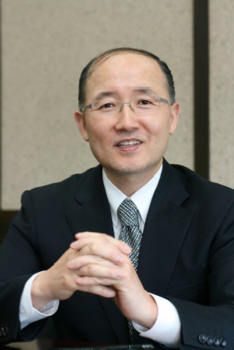SFU presents two free talks with Dr Kee Yeon Hwang, Korea Transport Institute president, Mar 29 and 31, 2011
SFU presents two free talks with Dr Kee Yeon Hwang, Korea Transport Institute president, Mar 29 and 31, 2011

Heads up for transit and planning enthusiasts: Dr Kee Yeon Hwang, president of Seoul’s Korea Transport Institute, will be giving two free talks at SFU on Tuesday March 29 and Thursday March 31, 2011!
Talk 1: on how Seoul replaced a downtown freeway with a stream
The Cheonggye Stream Revitalization Project: An Urban Transport Revolution in Seoul
Tuesday, March 29, 2011, 7 p.m.
Room 1400, Harbour Centre, SFU Vancouver
515 W. Hastings Street, Vancouver
Reserve your seat at www.sfu.ca/reserve
Dr Hwang’s first talk focuses on how Seoul replaced an urban expressway with a stream in the city centre, and the impacts to traffic and the urban paradigm. Restoring the stream has brought a new urban paradigm to Seoul that places more emphasis on sustainability and the pedestrian environment than on economic growth through vehicular movement.
Check out the poster for more detail! Of note: Vancouver councillor Geoff Meggs promoted this talk back in February, as it presents an interesting perspective on what might be possible with Vancouver’s existing viaducts.
Talk 2: on improving Seoul’s bus service by reforming operating practice
The Sustainability Dividend of Building a Better Bus System: Evidence from Seoul’s Public Transit Reform
Thursday, March 31, 2011, 7 p.m.
Room 2600, SFU Surrey
13450 – 102 Avenue, Surrey (just south of the Surrey Central SkyTrain station)
Reserve your seat at www.sfu.ca/reserve
Dr Hwang’s second talk explores how Seoul took its metropolitan bus service to a new level starting in July 2004, by reforming operating practices that greatly enhanced performance and service quality. This acclaimed reorganization of policy demonstrates the capacity of local government leadership to positively impact the economic efficiency of public transit, the consumer welfare of transit users, and the sustainability of urban mobility. Check out the poster for more detail!
As well…
I’ve got an opportunity to talk with Dr Hwang for a few minutes on the morning of Monday, March 28, 2011, so if you have any questions I should bring up, just let me know!
You can also find out more info on Dr Hwang’s talks at the SFU Urban Studies public talks page, which also includes recordings of past lectures from earlier Visiting Fellows like Ellen Dunham-Jones, Dr Andrew Thornley, Hank Dittmar, and James Kunstler.






The subject of transportation in Seoul (and more generally, South Korea) is one of my favourite ones. It’s a shame I didn’t catch this post earlier!
The transformation of Seoul’s urban landscape has been utterly transformed by the restoration of the Cheonggye Stream. The stream as essential to Seoul’s cityscape as False Creek is to that of Vancouver.
The city grew up around the stream in the first place, but as Seoul grew, the stream became not much more than a glorified drainage ditch. It was eventually covered over by a road and an elevated expressway, until a few years ago.
The restoration of the stream was emblematic of the transformation Seoul has gone through overall, from wartorn capital in the mid 1950s, to a gritty, rapidly growing and industrializing city in the 1970s, to the modern, post-industrial metropolis it is today.
And in place of a muddy ditch, a beautifully landscaped stream was built, replete with fountains, footpaths, bridges, and creative lighting. Now it’s a popular promenade for strolling and people watching.
Livability was not even a concept in Korea 20 or 30 years ago, but the city’s urban amenities are increasingly on a par with any typical European or North American city.
Likewise for the bus system…it has become increasingly user-friendly and sophisticated in recent years, with a fare system that has gone from all cash and no transfers to a seamlessly integrated smart card system that surpasses Vancouver in just a few years!
All that being said, I’m not sure it’ll be so easy to remove the Viaducts from Downtown Vancouver as it was to remove the “Samil Expressway” (as it was called) from Downtown Seoul. The latter provided a crosstown route through the city for which there are many other viable east-west alternatives.
The Georgia and Dunsmuir Viaducts, on the other hand, bypass the congested bottleneck of Gastown and Chinatown, providing a direct connection into the heart of Downtown for the thousands of commuters from Southeast Vancouver, Burnaby, Coquitlam, Delta, Surrey, and points up the valley.
Second paragraph should read: “Seoul’s urban landscape has been utterly transformed by the restoration of the Cheonggye Stream.”
Jhenifer:
If it’s not too late, I do have a question for Dr. Hwang.
Seoul is a city of 20 million people, a vibrant night life, and excellent public transportation. Its late night transportation, however, is sadly inadequate. Buses and trains stop running around midnight (there are no overnight services as in cities like London or New York), and taxis are famous for refusing to carry passengers, based on their destinations (according to frequent media reports).
Considering how many people are trying to get home late at night and how dependent the city is on public transportation, are there any plans to address this gap in service?
Thanks,
Stefan Ewing
[…] a major freeway to restore a downtown stream, and one on reforming Seoul’s bus system. (See this post for the talk […]
Sewing: ack! I didn’t manage to get your question in time. Sorry about that. The interview is up here now though.